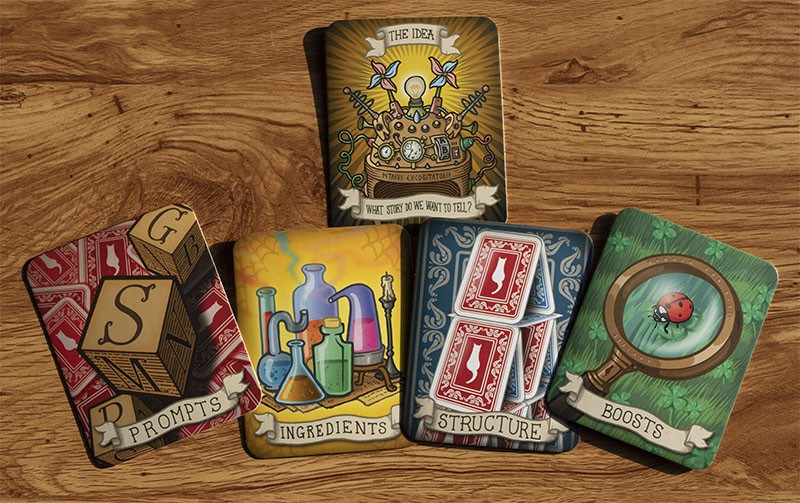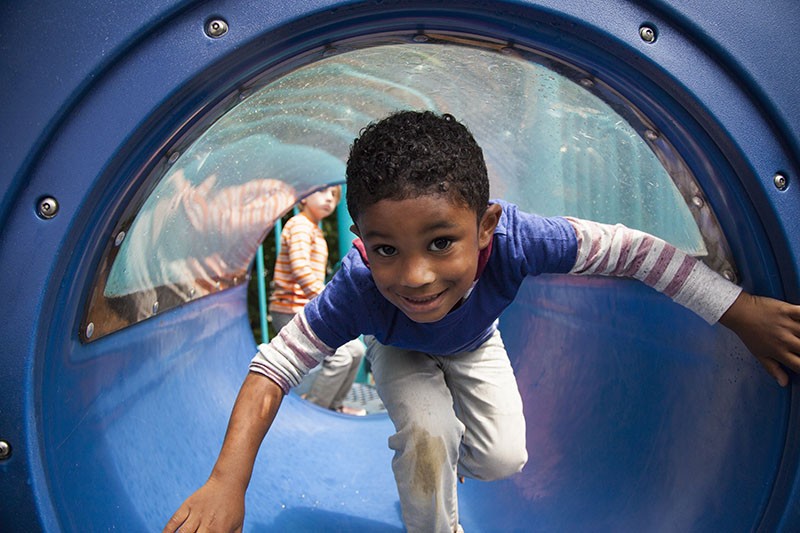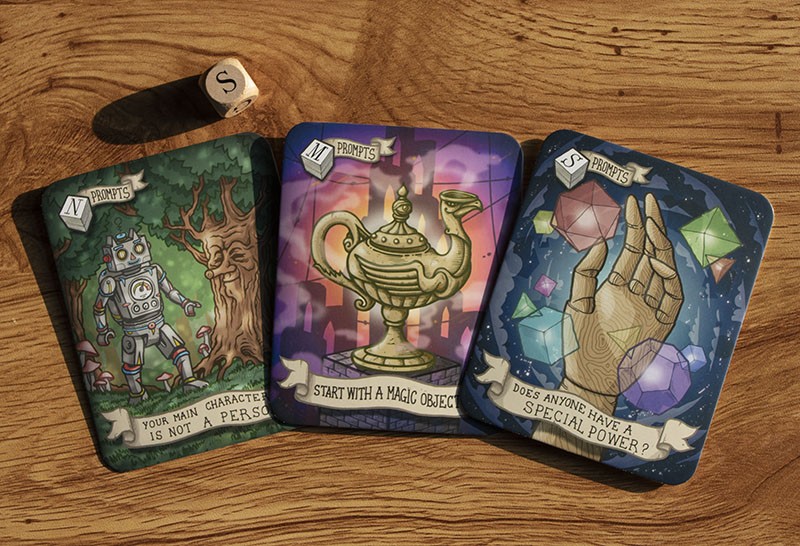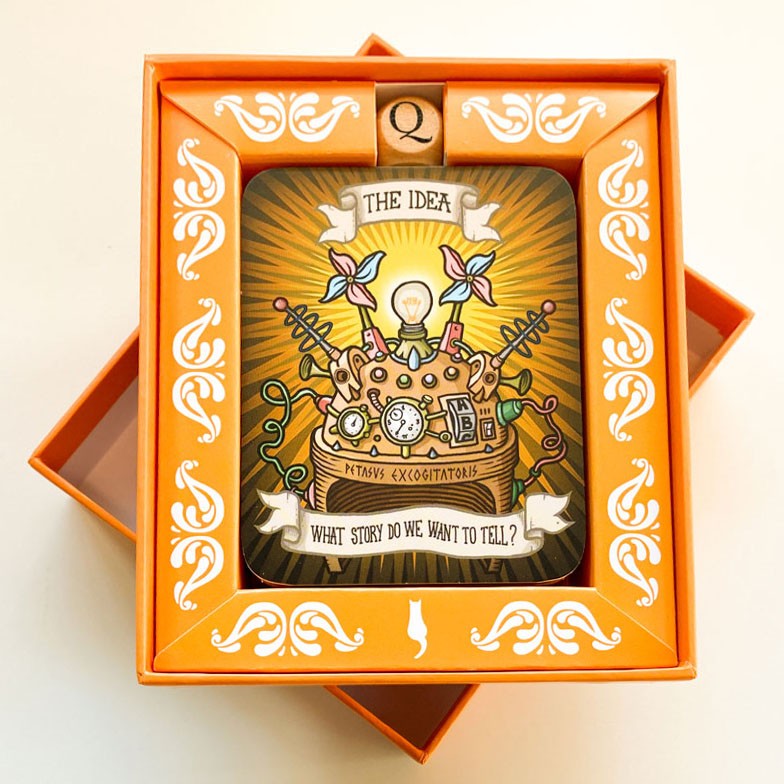Infinite Storytelling with the Fabula Deck for Kids
Parents and teachers, develop storytelling with the Fabula Deck for Kids. Write plays, picture books, puppet theatre and more! Inspire creativity and lifelong learning.
What is the Fabula Deck for Kids?
The Fabula Deck for Kids is a powerful story inspiring tool that helps kids, parents and schools quickly develop storytelling skills by providing a framework that helps develop story scenarios, characters and challenges that drive the story forward. Use it in groups, one-on-one, or individually to develop rich stories in any genre kids can imagine.
Now you can get 10% off your Fabula Deck for Kids when you enter our affiliate code, MURDOCK10 at checkout. Visit the Fabula shop, and remember to copy and paste our affiliate discount code MURDOCK10 at checkout for 10% off your ENTIRE order.
What is included in the Fabula Deck for Kids?
At the heart of the Fabula Deck for Kids are comes with 30 illustrated cards broken into five categories: the big idea, prompts, ingredients, structure, and boosts. To introduce some chance into your storytelling, it also comes with a die that corresponds with the story prompts. Roll the die to choose a random story prompt to challenge your story creators to discover something new.


Your Guide to Storytelling with the Fabula Deck for Kids
The deck also comes with a helpful booklet. The booklet is your guide. Whether you are using the deck for yourself, or you are a teacher creating stories with small teams, or parents helping your kids create a play to put on for friends and family, the booklet provides insights along the way.
How can YOU inspire infinite storytelling with the Fabula Deck for Kids?
There are many ways to inspire storytelling. The quickest way is to roll the die to select a prompt – character! Let’s develop a main character and describe who he she or they are and what the character’s hopes and dreams are for themselves. Let’s give them a friend or foe.
Now let’s draw another card – the consider the world these characters live in. Now we will describe their neighborhood or environment. What ordinary activities go on there? What is behind their environment in the wider world? Do your characters want to venture out there, or do they want to stay where things are familiar?
That might be enough for day one.
Alternately, we could start at the beginning with the first card: what story do we WANT to tell? Many creative people have a story they want to express. One of my first stories was about what it would be like to live in a house made of Jello. As a grown up, I still think that’s a pretty interesting idea.
The biggest secret in storytelling is to not push to finish the entire story at one time. That’s why the prompts on the cards are so helpful! We can put our story down, go have a snack, play at the park, and later in the day come back and develop a bit more of our story. Maybe we plan story time every day. That way we are always thinking up components of our story.
In fact, sometimes when we go away from our notebook, ipad, or computer and run around outside is when our best ideas come up. Moms and dads can keep a notebook or phone with them to jot down story notes. Have you ever gone to the park and imagined the playground is a giant castle and alligators live in the sand? Maybe you and your friends need to protect the castle from the alligators. That right there is a worthy story idea. Play it out on the playground, then bring your ideas back and write them down.
Just imagining all of this is getting my ideas going. I’m going to use my Fabula Deck for Kids, even though I’m a grownup. So here we are in story land…

Let’s tell a story:
In this example I will work from the Fabula Deck for Kids Prompts to come up with a story framework.
Each bulleted text comes from a prompt, and the paragraphs are what I wrote after checking the description in the booklet.
Idea:
“A little inconspicuous frog named Farnie finds an old oil lamp that contains a genie. The genie is unfortunately, retired and no longer grants wishes. After telling her story to the genie about how she’s the smallest and least noticed frog in the pond, the genie offers her a deal. He will give Farnie a magic gift, but Farnie must accept without knowing what the gift is. The gift will certainly make Farnie noticed by everyone in the pond, but the outcome could be very good or very bad in the end. There is only a .0172% chance it will turn out rather average. What’s most significant is that once she accepts the gift, it becomes a part of her that she can’t give up.
Farnie accepts the gift, something called a mogwiggle, and therein begins his journey.”
The story idea came from some of the prompts.
I rolled the die three times…
and came up with prompts N, S and M.
Prompt N: The main character is not a person! I chose a frog, a not uncommon character for a fairy tale.
Prompt S: Does anyone have a special power? The genie certainly does, but there’s a twist – the genie no longer uses his special power, so he…
Prompt M: gifts Farnie something magic that Farnie can’t yet understand until she uses it.

I then choose three ingredients cards.
I want to explore my main character, Farnie, and describe her more:
I want to understand the world she is in, the pond and how the pond works as an ecosystem:
Something happens – Farnie uses the mogwiggle and it changes things immediately across the whole pond. Now Farnie has to adapt.
Now I need to think about structure…
How the story unfolds:
Farnie’s ordinary world
The pond is lovely. Frogs from all over have congregated there because of the many lily pads and golden light that filters through the trees that surround the pond. The weather is warm and humid, and the area is rich with insect life, fish, songbirds, and only one threat to frogs – storks that migrate through twice per year.
Something changes:
One day Farnie finds the magic lamp and genie.
She accepts the mogwiggle and the story begins. The genie explains that the mogwiggle grants Farnie the power to give gifts, but the gifts are wrapped and she doesn’t know what they are until the recipient opens them. The gifts will manifest Farnie’s true feelings and intentions for the recipient, and those intentions will become real. Farnie takes the mogwiggle in her hands and it melts into thin air, becoming part of her.
She begins giving gifts with the power bestowed upon her by the mogwiggle and the first ones are great! She gives her mom a present and out fly a dozen tasty flies! Fat and slow, they are easy to snap up for a warm meal.
But…
Farnie experiences a trial: She’s expected to give a gift to a frog named Sal. Sal is a business frog who makes deals with everyone in the pond and has become very successful, but Sal has also always looked down on and ignored Farnie because she is so small and inconspicuous. Sal has never considered Farnie someone worth talking to.
Farnie has never liked Sal. She doesn’t want to give the gift because she is worried about what will happen. Maybe her negative opinion about Sal will become manifest though something horrible! But everyone pressures Farnie to give Sal a gift.
Everyone tells her, “Your gifts are so good! Give! Give! Give!”
Despite her inhibitions, Farnie puts her hand behind her back. A small wrapped gift appears in her hand and she gives it to Sal.
The gift becomes a stork, who gobbles up Sal in one bite!
Now the police, the mayor and everyone in the pond hop down to see what happened to Sal and what went wrong with Farnie’s gift.
Each person in the pond has something to say about Farnie. Some say she tricked Sal. Some say her early gifts were setting Sal up because he was so successful. Before the mogwiggle, no one had a thought in the world about Farnie, but now everyone does!
Farnie tries to explain it’s not her fault. She met a genie who gave her a mogwiggle which granted her the power to give magic gifts. It’s the mogwiggle that’s at fault. The mayor demands to see the mogwiggle, but Farnie can’t show it because the mogwiggle has already become a part of her.
The result:
Everyone believes it is nonsense and Farnie is cast out of the pond.
Farnie leaves the pond, hopping away dejectedly. She sleeps by a fence post in a field, and the next day hops to the other side of the field and discovers a river. “At least there is some water and flies here,” she thinks.
Farnie hops on a leaf to float down river hoping to find a new pond to live in where no one knows about her and her gifts.
Relapse:
But as Farnie floats down the river she she sees the old oil lamp stuck in the mud on the far bank. She hops off the leaf and swims against the current until she gets to the other side. She pulls the lamp out of the mud and polishes it.
The genie pops out of the lamp and Farnie tells him everything that happened, wondering what she can do to get back to her little pond, this time to get along with everyone.
Something happens again:
The genie tells Farnie she didn’t need the mogwiggle to be noticed – she just needed to speak up, tell people what she actually thinks and feels, and then learn to work with the others in the pond.
Farnie wonders if she there’s a way to extract the mogwiggle from inside of her.
The genie says given the circumstances, He’s willing to step back to partial retirement for one day in order to grant Farnie one wish.
Farnie accepts and wishes she had never accepted the mogwiggle in the first place.
Conclusion:
Farnie is back in his pond and she’s gone out and caught some fat flies to bring to his mother. Sal, the business frog that was eaten passes by to talk with the mayor about how to catch more flies to take to market by using a new product from his vinegar factory. Farnie speaks up and lets them know they can catch more flies with honey than with vinegar. The mayor listens to him and realize it’s a good idea. The community rallies to collect honey, and now everyone can catch as many flies as they need.
Boost:
What does Farnie learn?
She learned that she doesn’t need magic to gain attention and to become respected. Instead, she can be herself, speak up, and work collaboratively with others.
The End
How was that for a story?
Right now it’s just the rough outline. With more work I could describe the pond, the characters, the business environment in the pond, what it’s like to sleep next to a post when you’ve always slept on a lily pad before. Each bolded word is a prompt. I read the booklet for inspiration and wrote down my ideas, then I revised them a little bit and voila! I had the foundation of a story!
You can do it too. All it takes to tell a good story is a story structure and some prompts, plus your imagination!
The Fabula Deck for Kids is a set of 34 storytelling cards that provide a process to make story elements and structure manageable and fun! Get 10% off your order with discount code MURDOCK10
The deck is built to empower storytelling by providing a step-by-step process to develop characters, environment and props, then to put them into action. Find out what motivates your characters as they face and overcome challenges along the way.
The Fabula Deck for Kids includes:
- an easy to understand “storytelling system” to help develop each element at the right time in the storytelling journey
- six prompts to instigate story ideas
- four ingredients to develop the dynamic environment of your story
- nine structure cards that put your ideas, prompts, and ingredients in motion, creating the story
- ten “boost” cards to enliven your story and give it oomph.
- a booklet to help you along your storytelling journey.
- a six-sided die you can use to add chance to your storytelling process
- a sturdy carrying case to contain your Fabula Deck for Kids.

